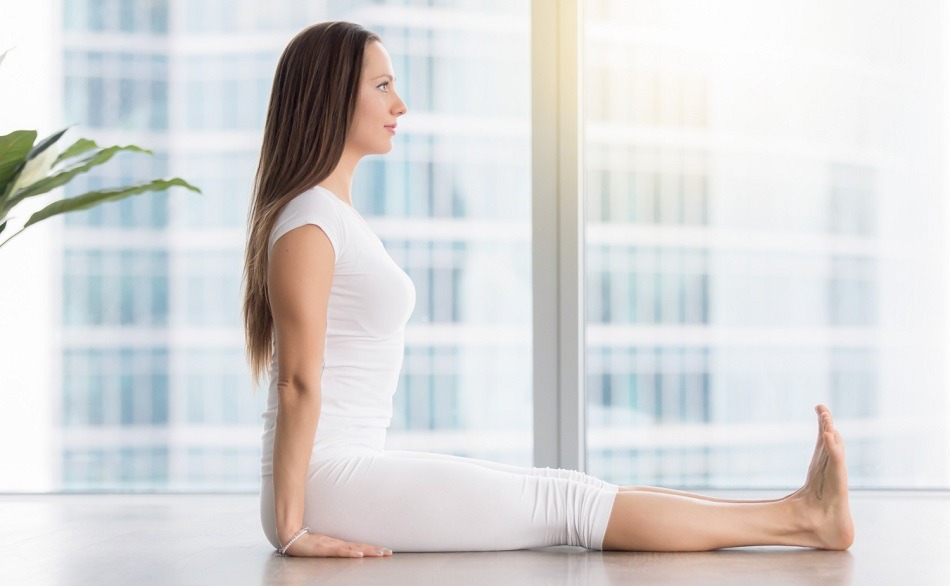
The Staff Pose, known as Dandasana in Sanskrit, is a fundamental seated posture in yoga that promotes stability, strength, and proper alignment. This pose serves as a foundation for many seated poses and forward bends, making it essential to understand and practice correctly.
How to do the Staff Pose (Dandasana)?
In this step-by-step guide, we will explore the techniques and alignment principles to help you master the Staff Pose.
Step 1: Begin in a Seated Position
Start by sitting on a yoga mat with your legs extended in front of you. Ensure that your spine is tall and upright, and your shoulders are relaxed. Place your hands alongside your hips, pressing firmly into the mat to create a stable foundation.
Step 2: Position Your Legs
Extend both legs forward, keeping them together and fully engaged. Activate your quadriceps by drawing the muscles of the thighs upward and engaging the kneecaps. Flex your feet, pointing your toes toward your face. Ground evenly through both sitting bones, distributing your weight evenly on the mat.
Step 3: Align Your Spine
Maintain an upright posture by lengthening your spine from the base of the pelvis to the crown of the head. Imagine a string pulling you upward, elongating the spine and creating space between each vertebra. Avoid slumping or rounding the back, and keep the shoulders relaxed and away from the ears.
Step 4: Engage Your Core
Activate your core muscles by gently drawing your navel toward your spine. This engagement provides stability and support for the spine while helping to maintain proper alignment in the pose. Focus on engaging the abdominal muscles without creating unnecessary tension in the body.
Step 5: Adjust Your Sitting Bones
Make sure your sitting bones are evenly grounded on the mat. If you find it challenging to maintain contact with the sitting bones, you can sit on a folded blanket or bolster to elevate the hips slightly. This modification helps to align the pelvis and supports a more comfortable and stable seated position.
Step 6: Relax Your Shoulders
Release any tension in your shoulders by consciously lowering them away from your ears. Soften the muscles of the shoulders and allow the shoulder blades to move down the back. This action creates space in the chest and encourages proper breathing.
Step 7: Align Your Head and Neck
Maintain a neutral alignment of the head and neck. Avoid tilting the head forward or backward. Instead, keep the chin parallel to the floor, with the back of the neck lengthened. Imagine a gentle lift through the crown of the head, as if being pulled upward by a string.
Step 8: Breathing and Mindfulness
Once you have settled into the Staff Pose, bring your attention to your breath. Take slow, deep breaths, allowing the abdomen to expand on each inhalation and contract on each exhalation. Cultivate a sense of calmness and mindfulness, focusing on the present moment and the sensations within your body.
Benefits of Staff Pose (Dandasana):
1. Stretches the Hamstrings: Staff Pose provides a gentle stretch to the hamstrings, which are often tight due to prolonged sitting or physical activities like running. Regular practice can help increase flexibility and range of motion in the hamstrings, promoting ease of movement.
2. Improves Spinal Awareness: By maintaining an upright and extended spine in Staff Pose, you cultivate better awareness of your spinal alignment. This posture helps to improve posture by lengthening and strengthening the muscles along the spine, promoting proper spinal curvature.
3. Relieves Lower Back Tension: Staff Pose helps to alleviate tension and discomfort in the lower back. As you engage the core muscles and sit with an upright posture, it reduces strain on the lower back, providing relief from stiffness and pain in that area.
4. Strengthens Back Muscles: Holding the extended position in Staff Pose engages the muscles of the back, including the erector spinae. Regular practice helps to strengthen these muscles, supporting a healthy spine and reducing the risk of back injuries.
5. Enhances Posture: As Staff Pose promotes proper spinal alignment, it naturally improves overall posture. By regularly practicing this pose and developing awareness of the alignment of your spine, you can carry this improved posture into your daily activities, reducing the strain on your back and neck.
6. Calms the Mind: Staff Pose encourages a sense of stillness and groundedness. As you sit in an upright position with focused breathing, it promotes a calm and centered state of mind. This can help reduce stress, anxiety, and restlessness, allowing you to find balance and tranquility.
Precautions and Modifications:
While Staff Pose offers numerous benefits, it is essential to practice with caution, especially if you have any pre-existing injuries or conditions. If you have tight hamstrings, you may need to bend your knees slightly or use props such as blankets or blocks to support your hands. Remember to listen to your body and modify the pose as needed to ensure comfort and avoid any strain or discomfort.
Staff Pose, or Dandasana, is a foundational seated posture in yoga that provides a range of benefits for the body and mind. From stretching the hamstrings to improving spinal alignment and promoting relaxation, regular practice of this pose can enhance your overall well-being. Incorporate Staff Pose into your yoga practice to experience its positive effects on flexibility, strength, posture, and mental calmness.










































